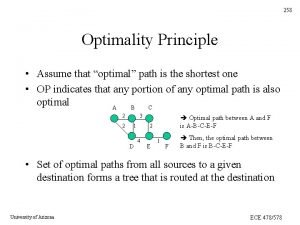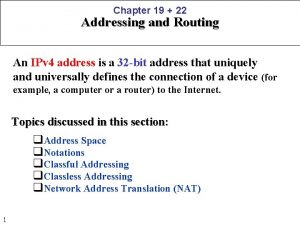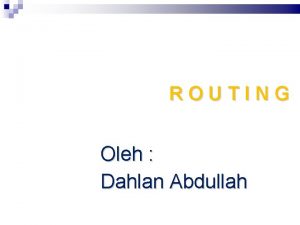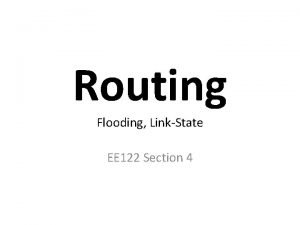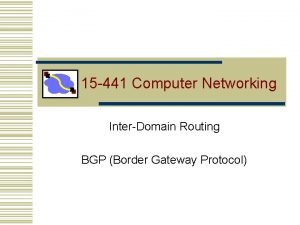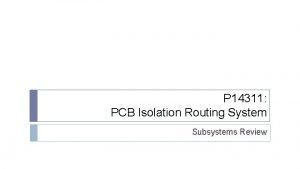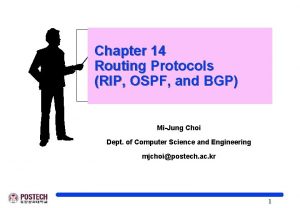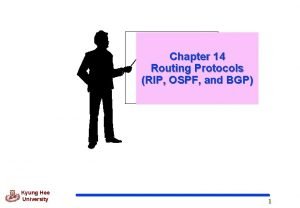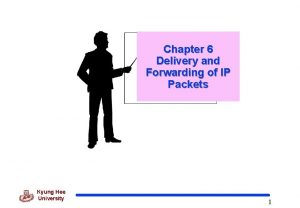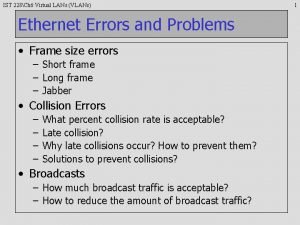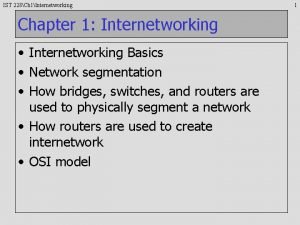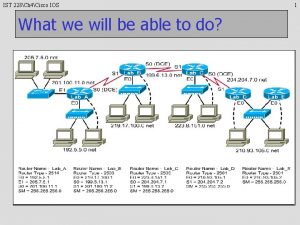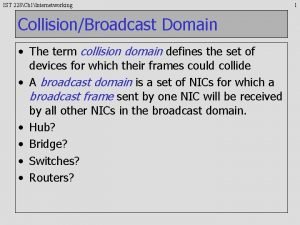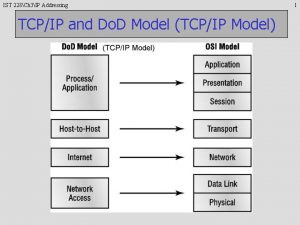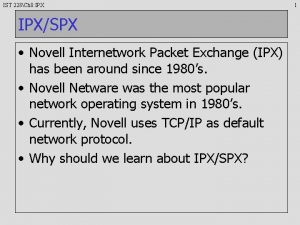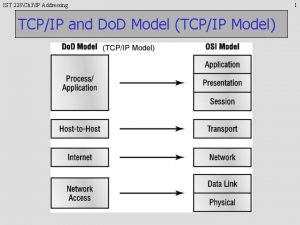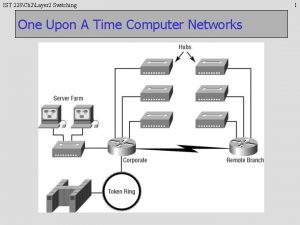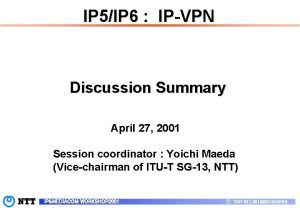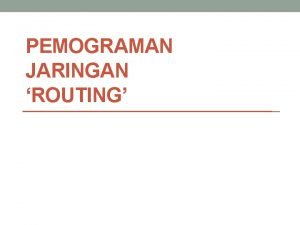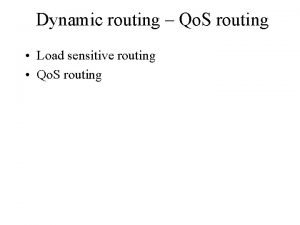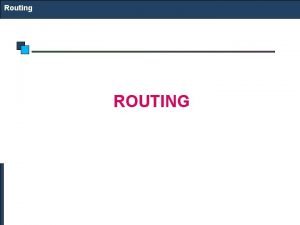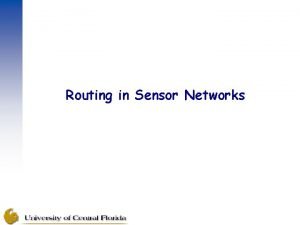IST 228Ch 5IP Routing 1 IST 228Ch 5IP
























- Slides: 24

IST 228Ch 5IP Routing 1

IST 228Ch 5IP Routing Review of Chapter 4 • Start the router simulator. You will see the prompt "Router>". This is the user mode prompt. Change the name of the router to Router 1. • Set the enable password to “en 123”. • Set the secret password to “secret 123”. • Try the passwords. • Set virtual terminal password to “vty 123” for the virtual terminal 0 -4 Router 1#config terminal Router 1(config)#line vty 0 4 Router 1(config-line)#login Router 1(config-line)#password vty 123 Router 1(config-line)#exit • Set console 0 password to “con 123” Router 1(config-line)#line console 0 • Now remove the passwords Router 1(config)#no enable password en 123 2

IST 228Ch 5IP Routing • Assign IP address for the Ethernet 0 interface. • Assign IP address for the Serial 0 interface. • Set the bandwidth of the Serial 0 interface to 56 Kps. Router 1(config-if)#bandwidth 56 • Set the bandwidth of the Serial 0 interface to 56 Kps. Router 1(config-if)#clock rate 56000 • Type “exit” to leave the serial interface and type “ctrl-z” to leave configuration mode. • Show the configuration of Ethernet 0, Serial 0 • Show the running configuration of Router 1 Backing up your configuration to a TFTP server Router 1#copy running-config tftp • Type “ 172. 10. 0. 10” for the TFTP host. • Type “Router 1” to name the destination file. Router 1#copy tftp running-config • Type “ 172. 10. 0. 10” for the TFTP host. • Type “Router 1” for the configuration file name. 3

IST 228Ch 5IP Routing • Nonroutable Protocols: – All communication occur on the one local net segment – Network source and destination infromation is not needed. – Net. BEUI (Net. BIOS Enhanced User Interface). • Routed Protocols: – Have packet headers with Network Layer address. – TCP/IP, Internetwork Packet Exchange/Squence Packet Exchange. – Every device must configured with a unique IP or IPX address. 4

IST 228Ch 5IP Routing 5 IP Routing • Routers forward packets by looking the routing table and discovering how to get remote networks. • A configured router have only information about directly connected networks. – What happens a router receives a packet with a network not listed in the routing table? Routing table for Router. C

IST 228Ch 5IP Routing Different Types of Routing • Static • Default • Dynamic 6

IST 228Ch 5IP Routing Static Routing • An administrator manually adds routes in each router’s table. • Benefits: – No overhead on the router CPU – No bandwidth usage between routers – Security • Disadvantages: – It is not feasible in large networks – Difficult to update – Administrators must know networking very well ip route [destination_network] [mask] [next-hop_address or exit interface] [administrative_distance] [permanent] 7

IST 228Ch 5IP Routing Setting a Static Routing Table Establishing routes: Router 1# show ip route : Router 1(config)# ip route 192. 168. 10. 0 255. 0 210. 16. 54. 1 This command establishes an IP route to network 192. 168. 20 Add all other required routes in the routing table Type “crtl-Z” to exit from configuration mode. Check the status of the routing table using show ip route Removing routes: Router 1(config)# no ip route 192. 168. 10. 0 255. 0 210. 16. 54. 1 Verifying: Router 1# ping 192. 168. 10. 50 8

IST 228Ch 5IP Routing Default Routing • Use to send packets with a remote destination network not in the routing table to the next-hop router. • You can only use default routing on stub networks-those with only one exit port out of the network. Router. A(config)#ip route 0. 0 192. 168. 12. 1 9

IST 228Ch 5IP Routing Why use Default Routing? 10

IST 228Ch 5IP Routing Dynamic Routing • In dynamic routing, protocols are used to find and update routing tables on routers. • A routing protocol defines the set of rules used by a router when communicating between neighbor routers. – Routing Information Protocol (RIP) – Interior Gateway Routing Protocol (IGRP) – Enhanced Interior Gateway Routing Protocol (EIGRP) • Types of routing protocols – interior gateway protocols (IGPs) • RIP, IGRP, EIGRP, OSPF – exterior gateway protocols (EGPs) • Border Gateway Protocol (BGP) • Types of IGPs – Distance Vector (RIP, IGRP) – Link State (OSPF) – Hybrid (EIGRP) 11

IST 228Ch 5IP Routing Dynamic Routing Basics • Hop count is the number of routers a packet must pass through to reach a particular network. • An autonomous system (AS) is a group of routers under the control of a single administration, sharing the same routing table information. • Administrative Distance is used to rate trustworthiness of routing information, 0 being the most trusted and the 255 least trusted. 12

IST 228Ch 5IP Routing Distance-Vector Routing Protocols • Each router broadcasts its entire routing table to neighbor routers at predetermined intervals (30 to 90 seconds). • Called routing by rumor 13

IST 228Ch 5IP Routing RIP Pinhole Congestion • Two updates list the same remote network? • Two updates list the same remote network and have the same AD and hop count? 14

IST 228Ch 5IP Routing Router Convergence Start Up Converged 15

IST 228Ch 5IP Routing Problems in Distance-Vector Routing • It takes up CPU process and link bandwidth. • If a network outage happens, slow converge of distance-vector routing protocols can cause inconsistent routing tables. • routing loops (counting-to-infinity). 16

IST 228Ch 5IP Routing Solutions • • Maximum Hop Count Split Horizon Route positioning Holddowns 17

IST 228Ch 5IP Routing Information Protocol (RIP) • a true distance-vector protocol • sends complete routing table out all interfaces every 30 sec. • uses only hop count to determine the best way. • has maximum allowable hop count of 15 • is inefficient on large networks • uses three different timers – route update timer – route invalid timer – flush timer 18

IST 228Ch 5IP Routing Setting up for Dynamic Routing • Configure your interfaces (see the next page) • Make sure that other routers in your network use the same routing protocol (RIP or IGRP). Lab_A(config)# router rip Lab_A(config-router)#network 201. 100. 11. 0 ^Z • Check your settings with show ip route • Use ping to verify configuration and connectivity of the network devices. • You can use passive-interface serial 0 to stop RIP updates from being propagated out serial interface 0, but it can still receive RIP updates. 19

IST 228Ch 5IP Routing Example for RIP configuration 20

IST 228Ch 5IP Routing Interior Gateway Routing Protocol (IGRP) • Cisco-proprietary distance-vector routing protocol that can work only with Cisco routers. • maximum hop count of 255 (100 default) • can use bandwidth and delay of lines in order to choose the best route. • Timers to control the performance – – update timers invalid timers holddown timers flush 21

IST 228Ch 5IP Routing 22 Commands to verify your configuration Commands Meaning show ip route shows you the routing protocols configured on your router and routing table show protocols displays all routed protocols and the interfaces on which they are enabled. show ip protocols shows the routing protocols with all timing associated with them debug ip rip displays routing updates in the console session as they are sent and received. debug ip igrp events displays a summary of the IGRP routing information running on the network debug ip igrp transactions displays the message request from neighbor routers asking for updates. undebug all turns all debugging off show running-config shows the configuration currently running on the router

IST 228Ch 5IP Routing 23 Commands for configuration routing Commands Meaning R(config)#router rip Turns on RIP routing on a router R(config)#router igrp [AS number] Turns on IGRP routing on a router R(config)#network [network IP] Identifies networks that routing table will be advertised by RIP and IGRP R(config)#ip route [IP] [mask] [interface IP] Creates static and default routes on a router R(config)#ip route [IP] [mask] [interface IP] Removes static and default routes R(config)#ip classes Tells a router to forward packets to a default route when the destination network is not in the routing table

IST 228Ch 5IP Routing Commands to configure dynamic 24
 Difference between clock routing and power routing
Difference between clock routing and power routing Reservoir routing example
Reservoir routing example Mark tinka
Mark tinka Continuity equation hydrology
Continuity equation hydrology Es ist herbst es ist herbst bunter blätter fliegen
Es ist herbst es ist herbst bunter blätter fliegen Es ist herbst es ist herbst bunter blätter fliegen
Es ist herbst es ist herbst bunter blätter fliegen Winter kommt winter kommt flocken fallen nieder
Winter kommt winter kommt flocken fallen nieder Zu glauben ist schwer. nichts zu glauben ist unmöglich
Zu glauben ist schwer. nichts zu glauben ist unmöglich Meine lieblingsjahreszeit ist der winter
Meine lieblingsjahreszeit ist der winter Optimality principle of routing
Optimality principle of routing Alsa route plugin
Alsa route plugin Routing switching adalah
Routing switching adalah Link state routing
Link state routing Precision queue vs skill groups
Precision queue vs skill groups Tabel routing static
Tabel routing static Link state routing protocol
Link state routing protocol Valley free routing
Valley free routing Rumor routing
Rumor routing Isolation routing
Isolation routing Hong kong university
Hong kong university Define a routing list as it pertains to incoming calls
Define a routing list as it pertains to incoming calls Rip ospf bgp
Rip ospf bgp Routing protocols rip ospf bgp
Routing protocols rip ospf bgp Delivery and forwarding of ip packets
Delivery and forwarding of ip packets Qbr quality based routing
Qbr quality based routing









